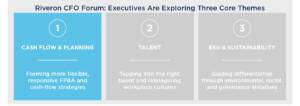CFOs Share Top Concerns – Part 1: Cash Flow and Financial Planning
Focusing on growth amid economic uncertainty? CFOs share key trends to move your organization forward.
A select group of private company chief financial officers (CFOs), many with private equity (PE) backing, recently met in a series of CFO forums to share leading practices, challenges, and approaches given the uncertain 2023 business outlook. Riveron experts hosted the sessions, providing insights for organizations seeking to safeguard strength amid uncertainty. Topics included evolving talent and sustainability strategies, and the discussion sparked several key cash flow and financial planning considerations:

Agile scenario-based planning and cash-flow strategies can position organizations for growth
In the highly volatile economic setting, leaders are enabling flexibility by planning for a range of scenarios. Doing so helps to position their organizations for growth as opportunities unfold and ensure responsiveness if faced with unexpected downturns. In anticipation, foresighted CFOs are developing multiple budget scenarios so they can make decisions in advance about what might trigger operational changes or more accurate performance targets. Similarly, some executives are opting to create one budget for the first half of the year and another for the second half—offering the flexibility to adjust for more resources if the first half performs well. Another approach could include preparing one realistic (or optimistic) budget for the board of directors and another very conservative version for the bank and lenders.
Whether an organization’s financial planning and analysis (FP&A) approaches are split up by scenario, timeframe, or audience, “break-glass-in-case-of-emergency” planning approaches could accelerate the ability to make mid-year course correction as leaders continue to contend with supply chain issues and pricing pressures.
In parallel with building flexibility into their FP&A approaches, CFOs are also looking for other strategic ways to optimize costs and ensure responsiveness regarding cash flow. Several CFOs are actively increasing pricing and have not yet experienced customer pushback, but it is something they monitor closely, especially in low-margin industries. Some organizations are taking action by offering deep discounts to customers in order to maintain a competitive edge, but —considering inflation and interest rates— CFOs should remain concerned about their vendors’ and customers’ credit strength (and risks) as well.
M&A Trends
Compared to last year’s activity, 89% of corporate development officers plan to do the same or more M&A deals in 2023
Read the study.
During the CFO forums, many executives shared that their companies are “investing against the curve,” seeing the present as an opportune time to complete mergers and acquisitions (M&A) and prepare for growth despite the economic uncertainties and rising interest rates. This trend paralleled a Riveron 2023 report finding that corporate development officers anticipate maintaining or increasing M&A in the year ahead compared to deal activity in the prior year.
In addition, when it comes to cash flow, today’s CFOs are exploring effective ways to ease the rising cost of capital. While many companies are still investing in capital expenditures, teams are doing so with the understanding that these efforts can often be put on hold or reimagined in order to free up more cash. These responsive strategies surrounding CapEx often provide less drastic impacts to an organization compared to cutting staff.
“Cutting heads… it’s hard to recover from that. We’ve always looked at deferring CapEx, eliminating CapEx, and then doing what we can regarding working capital, but the very last thing we looked at is reducing headcount.”
-CFO Forum Participant
While CapEx strategies are one important consideration, today’s CFOs are also looking at creative ways to guide phased budgetary needs through bonus incentive structures. Suppose companies are working with multiple budget phases. In that case, it can cause confusion or complexity regarding compensation and whether people will be held to different target metrics during the first and second half of the year. One CFO uses a conservative second-half budget, then enacts a target for accelerators. Here, if ample pipeline and opportunities exist during the second half of the year that outperforms the CFO’s conservative baseline plan, the company can be more generous with bonuses. Some CFOs also noted that private companies often enjoy more flexibility to enact these types of incentives.
Read other CFO insights in this series, including considerations for employee and workplace culture in Part 2: Talent plus how social and sustainability-focused strategies can enable a competitive edge in Part 3: ESG.
[1] Riveron CFO Forum hosts included Matt Bender, Eric Markovich, and Beth Saunders.

